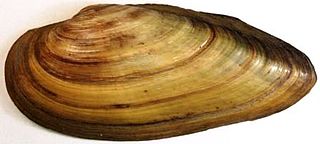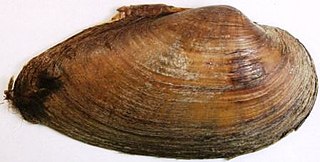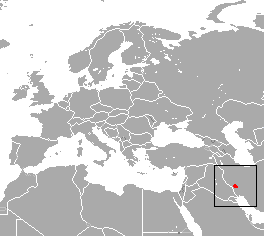
Tai Tam Road in Hong Kong links the districts of Chai Wan and Stanley on Hong Kong Island. This road connects Chai Wan Road, the northern end of Shek O Road, Turtle Cove, Tai Tam and Stanley. The Tai Tam Tuk Reservoir's dam constitutes a section of the road that is particularly narrow.

Unio crassus, the thick shelled river mussel, is a species of freshwater mussel, an aquatic bivalve mollusk in the family Unionidae, the river mussels.

Unio pictorum, the painter's mussel, is a species of medium-sized freshwater mussel, an aquatic bivalve mollusk in the family Unionidae, the river mussels.

Unio is a genus of medium-sized freshwater mussels, aquatic bivalve mollusks in the family Unionidae, the river mussels.

Unio tumidus, the swollen river mussel, is a species of freshwater mussel, an aquatic bivalve mollusc in the family Unionidae, the river mussels.

A species that is extinct in the wild (EW) is one that has been categorized by the International Union for Conservation of Nature as known only by living members kept in captivity or as a naturalized population outside its historic range due to massive habitat loss.
Madatyphlops cariei is an extinct blind snake species which was endemic to Mauritius. It is named for Paul Carié (1876–1930), an amateur naturalist attached to the Museum national d'Histoire naturelle, who made excavations in Mare aux Songes around 1900 where the remains of this species were discovered.

The Somali hedgehog is a species of mammal in the family Erinaceidae. It is endemic to Somalia and Somaliland. The Somali hedgehog is nocturnal.

The pale gray shrew is a species of mammal in the family Soricidae. It is endemic to Pakistan. It is threatened by habitat loss.

The Iranian shrew is a species of mammal in the family Soricidae. It is endemic to Iran. It is threatened by habitat loss.

The Lowe's shrew is a species of mammal in the family Soricidae. It is found in China, Myanmar, Thailand, and Vietnam.
Speleoperipatus is a monospecific genus of velvet worm in the Peripatidae family, containing the single species Speleoperipatus spelaeus. This species is a pale greenish yellow, almost white, with 22 or 23 pairs of legs and no eyes.

Lampsilis cardium is a species of freshwater mussel in the family Unionidae, the river mussels. It is known commonly as the plain pocketbook. It is widespread in eastern North America, where it is native to the Mississippi River and Great Lakes drainage systems.

Pleurobema oviforme, the Tennessee clubshell, is a species of freshwater mussel in the family Unionidae, the river mussels. It is native to the eastern United States, where it occurs in Alabama, Kentucky, North Carolina, Tennessee, and Virginia. It also previously occurred in Mississippi.
Unio turtoni is a species of medium-sized freshwater mussel, an aquatic bivalve mollusk in the family Unionidae, the river mussels.

Unio mancus is a species of freshwater mussel, an aquatic bivalve mollusk in the family Unionidae, the river mussels.












